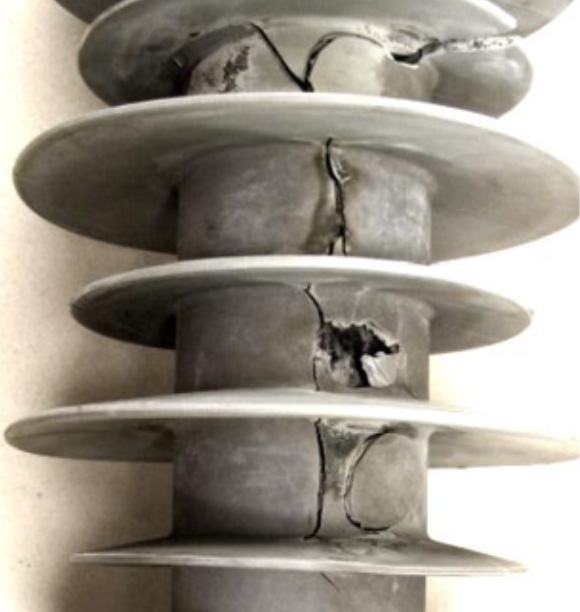The aging of composite insulators can be divided into three types: physical aging, chemical aging, and electromechanical aging.
Detail description of silicone rubber insulator physical aging:
The main factors of physical aging are ultraviolet radiation, local high temperature, and stress fatigue. Physical aging seriously affects the mechanical and electrical properties of silicone rubber. It was found that when silicon composite insulators are exposed to the outdoors for a long time, the photoelectric properties of composite insulators will change significantly. Among them, the changes in desert areas and subtropical plateau areas are most obvious.
Ultraviolet rays have a great accelerating effect on the aging of silicone rubber. Although ultraviolet rays can not completely cut off the main chain structure of silicone rubber, ultraviolet rays will work together with other factors to oxidize the side chain methyl of silicone rubber, eventually leading to the aging of silicone rubber. After the main chain structure in silicone rubber is broken, free radicals will be generated. These free radicals have a high ability and are easy to cross-link with each other. When free radicals are exposed to air, they will also react with oxidation in the air to produce gases such as methane.

In recent years, Chinese West-to-East Transmission Project has been gradually promoted. Yunnan, Guizhou, Sichuan and Tibet have built many high-voltage transmission lines with composite insulators as the main construction material. The natural environment in these areas is worse than other areas, and the composite insulator materials here are very prone to aging during use. In high-altitude areas such as Yunnan and Guizhou, as the ultraviolet irradiation time increases, the change in the strength and elongation time of silicone rubber gradually decreases, the resistivity will also decrease with the extension of irradiation, and the hydrophobicity of silicone rubber will show a continuous downward trend. The reasons for this phenomenon are: the main bonds in the composite insulator will be electrically connected under the action of ultraviolet rays, which will reduce the mechanical properties of silicone rubber. The cracking reaction will also produce gas, which will escape from the surface of silicone rubber, and the surface of silicone rubber will be uneven or even have holes.
The non-methyl groups on the side chain are partially detached due to oxidation reaction. At this time, the non-methyl groups cannot form a strong shield for the main chain, resulting in a gradual decrease in the hydrophobicity of the silicone rubber surface. In addition, the hydrophilic groups in silicone rubber will also absorb moisture from the surface of silicone rubber, causing accidents such as leakage. Therefore, if silicone rubber is placed in an environment with strong ultraviolet rays for a long time, cracking, cross-linking, oxidation and other reactions will continue to occur inside the silicone rubber, destroying the molecular structure inside the silicone rubber. From a macroscopic perspective, long-term exposure of silicone rubber to ultraviolet rays will lead to a decrease in the electrical and mechanical properties of silicone rubber, affecting the normal use of silicone rubber.
Studies have found that the colorant iron oxide can inhibit the oxidation reaction in the silicone rubber of composite insulators, thereby maintaining the stability of silicone rubber, but the use of colorant iron oxide acts as a catalyst for the hydrolysis reaction. When nano-silicon dioxide is added to silicone rubber, the probability of flashover voltage in the composite insulator decreases with the increase in the amount added. When nano-BN particles are added to silicone rubber, the surface temperature distribution of silicone rubber will be more uniform, the erosion depth will gradually decrease, the resistance stability of the silicone rubber surface will be enhanced, and the probability of flashover problems will continue to decrease.
Stress fatigue will also accelerate the aging of composite insulators to a large extent. Studies have found that when the shed of a composite insulator vibrates at high frequency, the vibration will cause a more serious stress concentration phenomenon at the root of the shed. Under long-term high-intensity loads, the root of the shed will always be in a state of stress fatigue, leading to the generation of microcracks. If the microcracks are not effectively repaired, the crack depth will continue to increase, eventually causing the shed to tear.